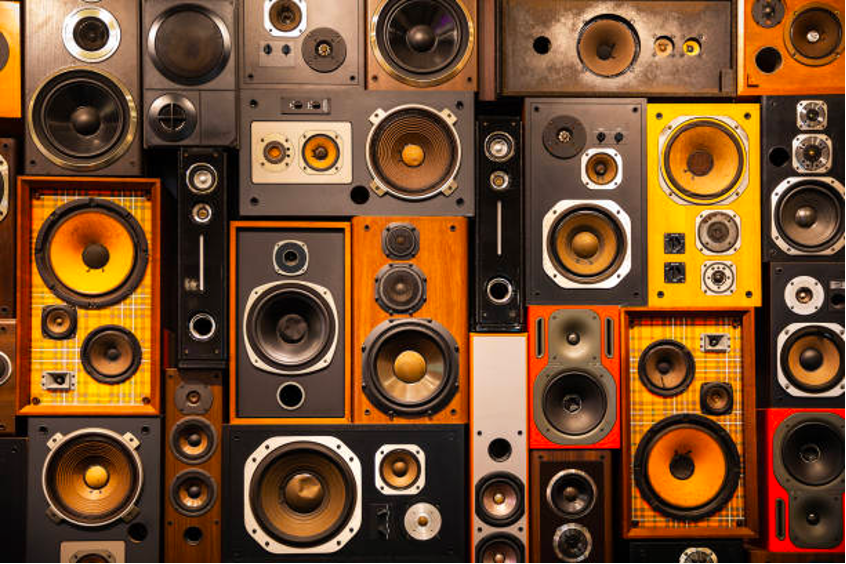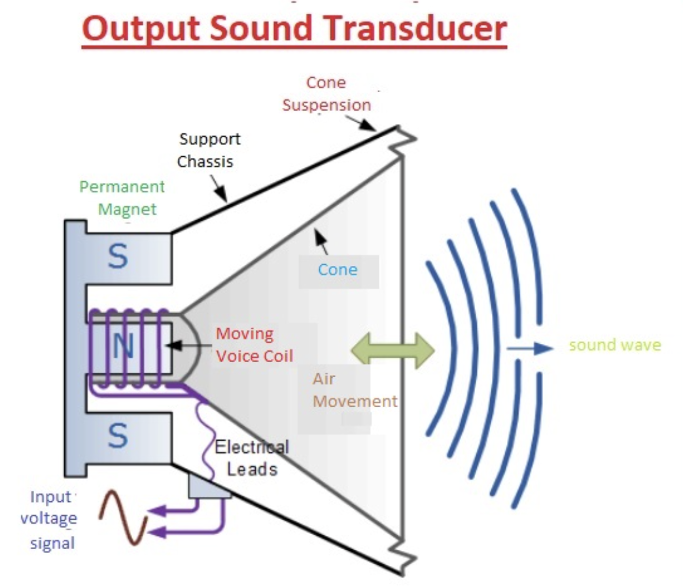A sound transducer, in simple terms, is a device that can convert sound signals into electrical signals or vice versa. These devices play a crucial role in our everyday lives, from the microphones that capture our voices during phone calls to the speakers that blast our favorite tunes. Sound transducers come in two main categories: input sensors and output actuators. Let’s delve into each of these and understand how they work.

What Does a Speaker Audio Transducer Do?
A speaker transducer, often simply called a speaker, is an example of an output actuator among sound transducers. Its primary function is to take electrical signals as input and transform them into sound waves that we can hear. You can think of it as the “voice” of your audio devices, like headphones or loudspeakers. But how exactly does this transformation happen?
Detailed Physics of Sound Transduction
To deepen the understanding of how sound transducers operate, it’s essential to delve into the physics underlying sound transmission. Sound waves are longitudinal waves consisting of compressions and rarefactions that travel through a medium. The speed of sound varies depending on the medium (e.g., air, water, solids) and is governed by the formula 𝑣=𝑓𝜆v=fλ, where 𝑣v is the velocity of sound, 𝑓f is the frequency, and 𝜆λ is the wavelength. In a transducer, such as a loudspeaker, electrical signals are converted into mechanical vibrations, which in turn produce sound waves by disturbing the medium around them. This conversion process can be quantitatively analyzed by examining the interactions between the magnetic field and the electric current in the device’s voice coil.
Component Analysis in Audio Transducers
Understanding the components that make up sound transducers provides insight into their functionality and design challenges. For instance, in a dynamic microphone, sound waves cause a diaphragm to vibrate, which in turn moves a voice coil within a magnetic field, generating an electrical signal through electromagnetic induction. This process can be intricately detailed by examining how variations in sound pressure affect the diaphragm’s motion, subsequently altering the electrical output. In loudspeakers, the reverse happens where the voice coil receives electrical signals, causing it to move within a magnetic field and drive the attached diaphragm to produce sound. This detailed breakdown helps explain the precise nature of sound production and reproduction in audio devices.
Practical Applications of Sound Transducers
To illustrate the practical utility of sound transducers, consider their role in a live concert setting. Microphones capture the performances of singers and instruments by converting sound waves into electrical signals. These signals are then processed, mixed, and amplified before being sent to loudspeakers, which convert them back into sound waves, filling the venue with music. This scenario highlights the critical role of transducers in entertainment and broadcasting, demonstrating their ability to capture and project sound across different mediums and environments. By understanding these applications, users can better appreciate the technology’s impact on everyday experiences like concerts and public announcements.
How Do Audio Transducers and Speaker Transducers Work?
To understand the magic behind sound transducers and speaker transducers, we need to peek into their inner workings. Let’s start with input sensors, like microphones. These devices capture sound waves, which are essentially vibrations in the air caused by various sources, from your voice to musical instruments. Microphones have diaphragms that move in response to these vibrations. As the diaphragm moves, it alters the electrical resistance, which is then converted into electrical signals. These signals can be processed and amplified for various applications, from recording your voice to making announcements at a concert.
Now, when it comes to speaker transducers, the process is the reverse. They take electrical signals and convert them into vibrations. Inside a speaker, there’s a coil of wire, known as the voice coil, suspended in a strong magnetic field. When an electrical signal passes through the voice coil, it creates an electromagnetic field that interacts with the permanent magnet’s field. This interaction causes the coil, attached to a diaphragm, to move back and forth rapidly. As the diaphragm moves, it compresses and rarefies the surrounding air, generating sound waves that match the original electrical signals. This is how your favorite songs get transformed from digital data into the music you hear.

Different Types of Speaker Audio Transducers
Speakers come in various shapes and sizes, each designed for specific purposes and sound qualities.
Moving Iron Speakers:
These speakers use a powerful magnet and an armature made of soft iron connected to a diaphragm. They change the magnetic reluctance of the circuit to produce sound, making them suitable for specific applications.
Moving Coil (Dynamic) Speakers:
These speakers have a coil of wire attached to a diaphragm within a capsule. They operate as pressure-operated microphones, producing sound by moving the coil in response to sound waves.
Ribbon Speakers:
Ribbon microphones have a conducting ribbon that generates the output.They are velocity-operated microphones and are known for their excellent linearity and directional response.
Piezoelectric Speakers:
These speakers use crystalline materials, such as Rochelle Salt or Barium Titanate, to generate sound. They are versatile and can be used in both air and solid materials, making them suitable for various applications, including high-frequency ranges.
Electrostatic Speakers:
Electrostatic speakers consist of a conductive diaphragm between two charged plates. They rely on changes in the charge of the diaphragm to produce sound and are known for their high-quality audio signals.
Each type of speaker transducer has its own unique characteristics and advantages, making them suitable for different audio applications. The choice of speaker depends on factors like frequency range, size, and directional response, allowing you to tailor your audio experience to your specific needs.

Technological Innovations in Audio Transducers
As technology continues to advance, so do sound transducers and speaker transducers. Innovations in materials, designs, and manufacturing processes have led to more efficient and higher-quality audio devices.
Piezoelectric Materials Advancements:
- Introduction: Advances in piezoelectric materials have led to more efficient and sensitive transducers.
- Key Benefits: Improved signal-to-noise ratios, increased sensitivity, and enhanced accuracy in various applications.
Microelectromechanical Systems (MEMS) Transducers:
- Introduction: MEMS technology has miniaturized transducers, making them smaller and more versatile.
- Key Benefits: Enables the integration of transducers into compact devices like smartphones, wearables, and medical instruments.
Digital Signal Processing (DSP):
- Introduction: DSP techniques enhance the signal quality and processing capabilities of transducers.
- Key Benefits: Improved noise reduction, signal filtering, and real-time data analysis for precise measurements.
Wireless Transducer Networks:
- Introduction: Wireless connectivity allows transducers to transmit data remotely.
- Key Benefits: Enables remote monitoring and control in various applications, from environmental sensing to industrial automation.
Fiber Optic Transducers:
- Introduction: Fiber optic technology has revolutionized transducer applications in sectors like telecommunications and sensing.
- Key Benefits: Immunity to electromagnetic interference, high data transfer rates, and long-distance signal transmission.
Nanotechnology Enhancements:
- Introduction: Nanoscale materials and structures improve the sensitivity and precision of transducers.
- Key Benefits: Enhanced detection of minute changes in physical parameters, leading to more accurate measurements.
Acoustic Wave Sensors:
- Introduction: Acoustic wave sensors utilize sound waves for highly sensitive measurements.
- Key Benefits: Applications in gas sensing, biosensing, and environmental monitoring, with improved selectivity and sensitivity.
Machine Learning Integration:
- Introduction: Machine learning algorithms are used alongside transducers to analyze complex data patterns.
- Key Benefits: Enhanced pattern recognition, predictive maintenance, and anomaly detection in various industries.
Energy Harvesting Transducers:
- Introduction: Transducers can convert ambient energy sources (e.g., vibrations or solar power) into electrical energy.
- Key Benefits: Sustainable power sources for low-power devices, reducing the need for external power supplies.
These technological innovations have significantly expanded the capabilities and applications of transducers across various fields, driving advancements in measurement accuracy, wireless connectivity, and energy efficiency.
In conclusion, sound transducers and speaker transducers are the unsung heroes behind our modern audio experiences. They work together seamlessly, converting sound into electrical signals and back again to bring music, voices, and all the sounds of our world to life. With ongoing technological advancements, we can expect even more exciting developments in the world of transducers, enriching our audio experiences further.




